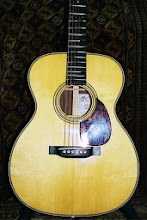Friday, May 29, 2009
Wednesday, May 27, 2009
Progression Circle m6/m3 Con’t
OK, I realized my ignorance here. It dawned on me this morning that there was a reason why there were 7 half steps between some notes and 17 half steps between others. What I thought was unique was nothing more than a circle of sevenths. When you actually play this progression you recognize the pattern. The m6 meant nothing – it was just an additional note I was throwing in there before continuing with the circle of 7ths. The other way of looking at it is that any two intervals adding up to 9 returns you to the octave. A m6th and a maj3rd get you back to the octave. That 17 I was seeing was a half step from 18 (2 X 9), which would be one half step short of the second octave – the 7th. Playing these little mathematical games is how I learn theory, so I don’t consider it a waste of time in doing it. But the progression was nothing special, either.
Tuesday, May 26, 2009
Progression Circle m6/m3
I had a music theory idea that I want to play with and see if I can get a song out of it. It’s born out of the concept of the circle of fourths and fifths. And I was wondering if I could circle a combination of two intervals. The two that came to mind were a minor 6 and a minor third. Or, in relation to the root, it would be I-vi-VII. The VII would then become the new tonic and you would move another m6, and a m3 in relation to the m6. So, I worked this out in the key of C. The progression would be
C-G#-B-G-A#-F#-A-F-G#-E-G-D#-F#-D-F-C#-E-C-D#-B-D-A#-C#-A-C
The thing that stands out is that all of these notes appear twice but the period between when they come up a second time varies.
C Twice 17
G# Twice 7
B Twice 17
G Twice 7
A# Twice 17
F# Twice 7
A Twice 17
F Twice 7
E Twice 17
D# Twice 7
D Twice 17
C# Twice 7
The C comes up seventeenth for the second time. The G# comes up seventh after its first appearance.
The other thing I notice is that to get back to the original C, it takes 24 tones. How about using 24 bars to do that in? And how about using a rhythmic pattern that alternates? Maybe the first appearance of a note utilizes whole and half notes. Maybe the second appearance utilizes quarters and eighths. So that’s the starting point for my next songwriting session.
C-G#-B-G-A#-F#-A-F-G#-E-G-D#-F#-D-F-C#-E-C-D#-B-D-A#-C#-A-C
The thing that stands out is that all of these notes appear twice but the period between when they come up a second time varies.
C Twice 17
G# Twice 7
B Twice 17
G Twice 7
A# Twice 17
F# Twice 7
A Twice 17
F Twice 7
E Twice 17
D# Twice 7
D Twice 17
C# Twice 7
The C comes up seventeenth for the second time. The G# comes up seventh after its first appearance.
The other thing I notice is that to get back to the original C, it takes 24 tones. How about using 24 bars to do that in? And how about using a rhythmic pattern that alternates? Maybe the first appearance of a note utilizes whole and half notes. Maybe the second appearance utilizes quarters and eighths. So that’s the starting point for my next songwriting session.
Monday, May 25, 2009
Where to Find Different Music
Finding music that is on the edge of what everyone else is listening to is a passion of mind. One very important site that has helped me find new artists is Squidco. If you sign up for their e-mail newsletter they will send brief descriptions of new items. I've found several great pieces of music this way. Check them out at www.squidco.com

